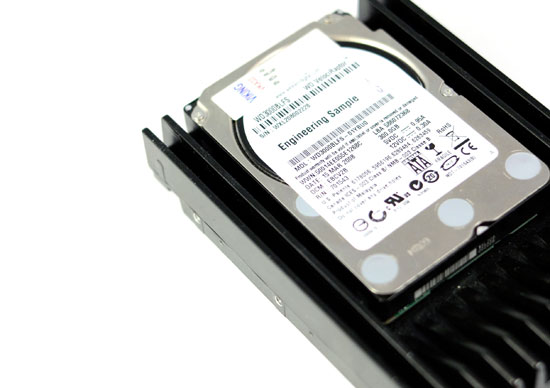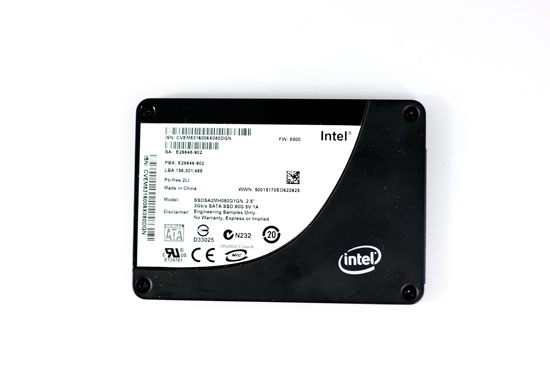The SSD Anthology: Understanding SSDs and New Drives from OCZ
by Anand Lal Shimpi on March 18, 2009 12:00 AM EST- Posted in
- Storage
Why You Should Want an SSD
For the past several months I’ve been calling SSDs the single most noticeable upgrade you can do to your computer. Whether desktop or laptop, stick a good SSD in there and you’ll notice the difference.
I’m always angered by the demos in any Steve Jobs keynote. Not because the demos themselves are somehow bad, but because Jobs always has a perfectly clean machine to run the demos on - and multiple machines at that. Anyone who has built a computer before knows the glory of a freshly installed system; everything just pops up on your screen. Applications, windows, everything - the system is just snappy.
Of course once you start installing more applications and have more things running in the background, your system stops being so snappy and you tend to just be thankful when it doesn’t crash.
A big part of the problem is that once you have more installed on your system, there are more applications sending read/write requests to your IO subsystem. While our CPUs and GPUs thrive on being fed massive amounts of data in parallel, our hard drives aren’t so appreciative of our multitasking demands. And this is where SSDs truly shine.
Before we go too far down the rabbit hole I want to share a few numbers with you.
This is Western Digital’s VelociRaptor. It’s a 300GB drive that spins its platters at 10,000RPM and is widely considered the world’s fastest consumer desktop hard drive.

The 300GB VelociRaptor costs about $0.77 per GB.
This is the Intel X25-M. The Conroe of the SSD world, the drive I reviewed last year. It costs about $4.29 per GB; that’s over 5x the VelociRaptor’s cost per GB.

The VelociRaptor is the dominant force in the consumer HDD industry and the X25-M is the svelte bullfighter of the SSD world.
Whenever anyone mentions a more affordable SSD you always get several detractors saying that you could easily buy 2 VelociRaptors for the same price. Allow me to show you one table that should change your opinion.
This is the Average Read Access test from Lavalys’ Everest Disk benchmark. The test simply writes a bunch of files at random places on the disk and measures how long it takes to access the files.
Measuring random access is very important because that’s what generally happens when you go to run an application while doing other things on your computer. It’s random access that feels the slowest on your machine.
| Random Read Latency in ms | |
| Intel X25-M | 0.11 ms |
| Western Digital VelociRaptor | 6.83 ms |
The world’s fastest consumer desktop hard drive, Western Digital’s 300GB VelociRaptor can access a random file somewhere on its platters in about 6.83ms; that’s pretty quick. Most hard drives will take closer to 8 or 9ms in this test. The Intel X25-M however? 0.11ms. The fastest SSDs can find the data you’re looking for in around 0.1ms. That’s an order of magnitude faster than the fastest hard drive on the market today.
The table is even more impressive when you realize that wherever the data is on your SSD, the read (and write) latency is the same. While HDDs are fastest when the data you want is in the vicinity of the read/write heads, all parts of a SSD are accessed the same way. If you want 4KB of data, regardless of where it is, you’ll get to it at the same speed from a SSD.
The table below looks at sequential read, sequential write and random write performance of these two kings of their respective castles. The speeds are in MB/s.
| Sequential Read (2MB Block) | Sequential Write (2MB Block) | Random Write (4KB Block) | |
| Intel X25-M | 230 MB/s | 71 MB/s | 23 MB/s |
| Western Digital VelociRaptor | 118 MB/s | 119 MB/s | 1.6 MB/s |
If you’re curious, these numbers are best case scenario for the VelociRaptor and worst case scenario for the X25-M (I’ll explain what that means later in the article). While the VelociRaptor is faster in the large block sequential writes look at the sequential read and random write performance. The X25-M destroys the VelociRaptor in sequential reads and is an order of magnitude greater in random write performance. If you’re curious, it’s the random write performance that you’re most likely to notice and that’s where a good SSD can really shine; you write 4KB files far more often than you do 2MB files while using your machine.
If the table above doesn’t convince you, let me share one more datapoint with you. Ever play World of Warcraft? What we’re looking at here is the amount of time it takes to get from the character selection screen into a realm with everything loaded. This is on a fully configured system with around 70GB of applications and data as well as real time anti-virus scanning going on in the background on every accessed file.
| WoW Enter Realm Time in Seconds | |
| Intel X25-M | 4.85 s |
| Western Digital VelociRaptor | 12.5 s |
The world’s fastest hard drive gets us into the game in 12.5 seconds. The Intel X25-M does it in under 5.
SSDs make Vista usable. It doesn’t matter how much background crunching the OS is doing, every application and game launches as if it were the only thing running on the machine. Everything launches quickly. Much faster than on a conventional hard drive. If you have the ability, try using your system with a SSD for a day then go back to your old hard drive; if that test doesn’t convince you, nothing will.
That’s just a small taste of why you’d want an SSD, now let’s get back to finding a good one.










250 Comments
View All Comments
coil222 - Wednesday, March 18, 2009 - link
Yes I run a pair of MTRON 7500s in a raid 0 stripe for my OS and Gaming (wow). I don't recall numbers off the top of my head but tests were better on the raid 0 than a single drive configuration.Watch this:
http://www.youtube.com/watch?v=96dWOEa4Djs&fea...">http://www.youtube.com/watch?v=96dWOEa4Djs&fea...
sawyeriii - Wednesday, March 18, 2009 - link
I just wanted to state how much I loved the combination of technical and real world information in this article.What is the possibility of having different page sizes built into a drive? I.e. you could have a drive with many 1k page packages on one die, 2k on another, and most others 4k. Could that theoretically help? Could the controllers work with that (or would you need to combine multiple 1k's into a 4k transfer size)?
PS One note on page 3, the VelociRaptor and Intel in the first chart (responce time) are switched, however the text is correct.
StormyParis - Wednesday, March 18, 2009 - link
the ugly truth is that an SSD won't let you do anything that you couldn't do without it, and due to its cost and small capacity, it's not a replacement drive, it's an extra drive: not less power consumption but more, not less noise but just the same. You just gain a bit of time when booting up and lauching apps... which I do about 1/week and 1/day, respectively. Assuming your system has enough RAM (and if it doesn't, buy RAM before buying an SSD !), you won't feel much difference once the apps are launched.For the same cost, I'd rather buy a bigger screen.
It's urgent to wait for prices to come down. But I'm all for lots of people buying them now and help get the price down for us wiser buyers.
Rasterman - Thursday, March 19, 2009 - link
I've already decided my next system in a few months will have one, after you go through 5 hard drive failures (over several years) lets see how much your willing to pay to not have to put up with it anymore. If you use your PC for anything useful (work) then an SSD is a no brainer even at $1000/64GB IMO if the data security is there, speed is secondary for me.When you already have the best screen, video card, memory, why not have the best drive? And your argument is pretty dumb, almost any upgrade won't let you do anything that you couldn't do without it, not just SSDs.
Calin - Wednesday, March 18, 2009 - link
You get lower power due to the lower power use of the SSD and the fact that the other drive is not stressed with difficult access patterns (small random reads/writes). Remember that idle power of a SSD drive is very low7Enigma - Wednesday, March 18, 2009 - link
No, his comment was accurate for most users. Due to the small capacities and high cost these will be used as boot drives primarily with maybe a single heavily used program (say the current game or program you are playing/using), the rest will be on an additional drive. So while the power consumption of the SSD would be less than the old drive, the aggregate power usage of both (even when the larger storage drive is primarily at idle) will be higher than the single HD.And I believe you meant to say traditional HD for idle power?
strikeback03 - Wednesday, March 18, 2009 - link
If all you were going to throw on the drive is the OS and a game, a 32GB drive should be plenty. The reason the 80GB and up range is important is so general consumers can load all their programs on it.But yes, in consumer usage other than a laptop, some people who were previously using one drive for both boot and storage would likely need a mechanical HDD is addition to the SSD. OTOH, those who were using a Velociraptor (or RAID array) for boot and another drive for storage will see their power consumption decrease.
sawyeriii - Wednesday, March 18, 2009 - link
Have you used a SSD? (If so which)I would state that it is not a luxary product, it is a premium product. The price difference you pay WILL translate to faster performance (if you choose correctly). More RAM only helps upto a point.
Remember performance is based on a system of parts...
CPU
RAM
NORTHBRIDGE
GPU
SOUTHBRIDGE
I/O INTERFACE
HDD/SDD
Microsoft's Windows Experience Index has specific flaws, but the concept is sound... The system can only go a fast as the slowest component in the system (relative to the amount of time used by that component).
Testtest - Wednesday, March 18, 2009 - link
... there's also Supertalent's Ultradrive ME (MLC) and LE (SLC) and Photofast's G-Monster v3At least the Supertalent drives are quite a bit cheaper with the same drive layout/controller than the Vertex drives and only differ in the firmware (which isn't bad either).
It's however possible at least with the Ultradrive ME currently to provoke a kinda timeout error after they've been fully filled once and then still beeing written on. I don't own a Vertex so I can't test that there but if it was a controller issue, it should pop up there sooner or later as well (if you take a look in their suppport forum some error reports seem very similar).
Intels have their 80% bug, Indilinx drives have their issues too it seems - let's hope that firmware can cure it!
Great article btw!
iwod - Thursday, March 19, 2009 - link
Both SuperTalent and OCZ 30 / 32 GB drive cost exactly the same on NewEgg$129